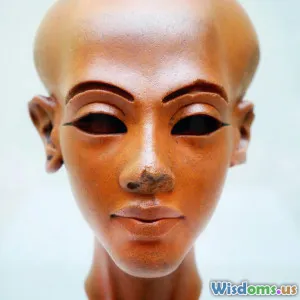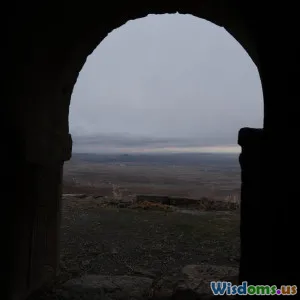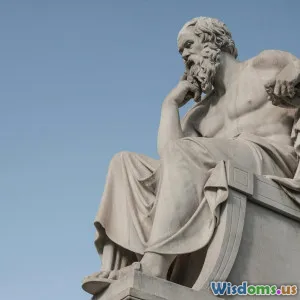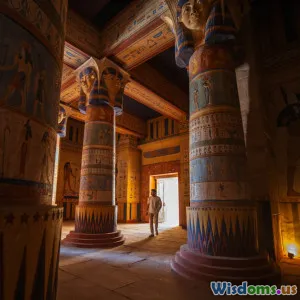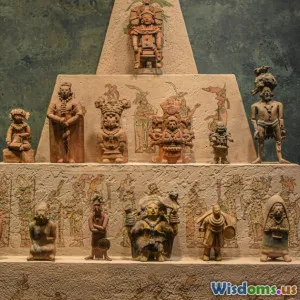
Artifacts That Shaped Civilizations
8 min read Discover key artifacts that transformed ancient civilizations and unlocked archaeological mysteries shaping human history. (0 Reviews)
Artifacts That Shaped Civilizations: Unlocking Ancient Mysteries
Introduction
From the dawn of human societies, artifacts have served as windows into the lives, beliefs, and innovations of ancient peoples. These tangible relics from long-gone civilizations reveal stories far richer than simple objects. They embody breakthroughs that transformed societies – the birth of writing, early tools fostering agriculture, religious icons shaping identity, and technological marvels fueling progress. This article delves into some of the most crucial artifacts that not only shaped civilizations but continue to intrigue archaeologists and historians, unveiling mysteries that redefine our understanding of the past.
The Rosetta Stone: Decoding Ancient Languages
Arguably one of the most significant archaeological finds, the Rosetta Stone, discovered in 1799 near the Egyptian town of Rosetta, unlocked the secrets of Egyptian hieroglyphs, a language unknown for over a millennium. The slab contains the same text inscribed in three scripts: Greek, Demotic, and hieroglyphic.
Before the stone's discovery, understanding Egyptian writing was virtually impossible, rendering Egypt’s vast historical records mute. Jean-François Champollion’s 1822 breakthrough using the Rosetta Stone as a linguistic key unlocked ancient Egyptian language, allowing scholars access to inscriptions, religious texts, and royal records that vastly expanded knowledge of ancient Egypt's civilization, religion, and governance.
Insight: The Rosetta Stone exemplifies how one artifact can revive an entire culture's narrative and transform historical linguistics.
The Code of Hammurabi: Foundation of Legal Systems
Originating from ancient Babylon around 1754 BCE, the Code of Hammurabi is among the earliest and most complete written legal codes. Carved into a basalt stele standing over 7 feet tall, it consists of 282 rules covering crimes, property rights, trade regulations, and social obligations.
Its impact lies in establishing the concept of codified law publicly accessible to citizens—an essential step in governance and justice. The principle “an eye for an eye” resonates through subsequent legal traditions, influencing numerous civilizations.
This code reveals societal priorities and stratifications; certain punishments varied depending on social class, reflecting intricate social hierarchies. The artifact thus isn’t just a legal document but a mirror reflecting civilization’s complexity and values.
The Antikythera Mechanism: Ancient Technological Marvel
Discovered in a shipwreck off the Greek island of Antikythera in 1901, this bronze device dating to around 100 BCE stuns modern researchers due to its intricate gearing system which mimicked celestial cycles. Often called the world’s first analog computer, it could predict astronomical positions, eclipses, and even the timing of the ancient Olympic Games.
Its precision baffled experts until recent x-ray scans revealed dozens of tiny interlocking gears. Such sophistication predates similar technology by over a millennium, shedding light on Hellenistic scientific genius.
The existence of the Antikythera Mechanism challenges assumptions about ancient technology and engineering capabilities, opening new discussions about lost knowledge in historical epochs.
The Terracotta Army: Guardians of the Afterlife
Unearthed in 1974 near Xi’an, China, the Terracotta Army comprises thousands of life-sized clay soldier figures buried with Emperor Qin Shi Huang (259–210 BCE). Created to protect the emperor in the afterlife, this discovery provided unparalleled insight into the militaristic culture and artistry of the Qin dynasty.
Each figure is unique, detailed with differing facial expressions, uniforms, and weapons, demonstrating colossal craftsmanship. Beyond funerary customs, the army illustrates the power centralization and state organization that unified China.
Historian John Man notes, “The army is not merely a tomb guardian but a statement of imperial might and unification.” This makes the Terracotta Warriors a vital artifact for understanding ancient Chinese political ideology and social order.
The Dead Sea Scrolls: Illuminating Religious History
Discovered between 1947 and 1956 in caves near Qumran by the Dead Sea, these ancient Jewish manuscripts date from the third century BCE to the first century CE. The scrolls include biblical texts, sectarian writings, and commentaries providing unmatched insights into Judaic practices and early Christianity.
The scrolls are pivotal for biblical scholarship, featuring some of the oldest surviving copies of Hebrew scriptures. They also provide corroboration and distinctions between religious doctrines, enhancing comprehension of theological evolution.
Moreover, they raise intriguing questions about diverse Jewish sects and apocalyptic beliefs at the cusp of the Common Era, making them a cornerstone in the archaeology of religion.
Conclusion
Artifacts serve as bridges linking past and present, embodying the ingenuity, belief systems, and socio-political structures of civilizations. The Rosetta Stone revolutionized linguistics; the Code of Hammurabi laid foundational legal principles; the Antikythera Mechanism astonished with scientific foresight; the Terracotta Army mirrored imperial power; and the Dead Sea Scrolls deepened understanding of religious history.
Each of these relics defies the passage of time to tell vivid stories, illustrate progress, and pose new questions. Continued discoveries and technological advances such as 3D scanning and DNA analysis promise to uncover more secrets, reinforcing the power of artifacts to shape how we comprehend human civilization.
Whether an archaeologist deciphering inscriptions or a curious reader pondering history, these artifacts invite us to embark on an endless journey through time, inspiring both awe and scholarship.
References
- Parkinson, R. B. The Rosetta Stone and the Rebirth of Ancient Egypt. Taylor & Francis, 1999.
- Van De Mieroop, M. King Hammurabi of Babylon: A Biography. Wiley-Blackwell, 2005.
- Freeth, T., and Jones, A. Decoding the Heavens: A 2,000-Year-Old Computer and the Century Long Search to Discover Its Secrets. Da Capo Press, 2008.
- Man, J. The Terracotta Army: China’s First Emperor and the Birth of a Nation. Generus Publishing, 2007.
- Schiffman, L. H. Reclaiming the Dead Sea Scrolls. Jewish Publication Society, 1995.
Rate the Post
User Reviews
Popular Posts










